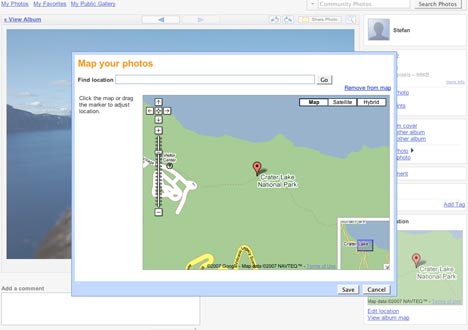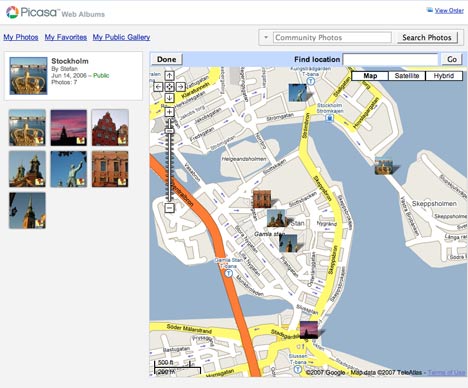In a continuing trend to have users add location metadata to content uploaded to Google servers (following YouTube), Google’s Picasa Web Albums has now gained the ability to let you georeference photos from inside the browser, using Google Maps. Here is the announcement on the Official Google Blog.
How does this newfound ability compare to the georeferencing via Google Earth available for a while now in the standalone version of Picasa (for Windows and Linux), or the georeferencing already available on Flickr and Google’s own Panoramio?
First, here is how it works in Picasa Web Albums (henceforth “PWA”): Everything is focused on simplicity. For any photo in your online account (1GB comes free), there is now an “Add location” link, which leads to an Ajax-ish Google Maps popup on the page itself that first forces you to search for a place and then lets you tweak the exact location.

Georeference a number of photos in an album, like this one of Stockholm photos I have laying around, and the album itself can be viewed on a page in a layout that looks remarkably much like Google My Maps, down to the “View in Google Earth” link — which gets many kudos for its seamless integration. From this page, you can perform further tweaks simply by dragging the photos on the map. It couldn’t be any easier.

 |
| Stockholm |
But there is one significant omission when compared to all the other services: Upload a photo that already has coordinate data in its EXIF metadata, as I did here, and it is not automatically mapped — you still have to georeference it manually.
If instead you first import the same photo to the standalone Picasa application, it does recognize the EXIF coordinate data, and will show you its location if you choose the menu item “Tools > Geotag > View in Google Earth”. If you then sign on to PWA from within Picasa, and upload such a photo to PWA, as I did here, PWA does automatically georeference it. (This makes Picasa far more geo-savvy than Apple’s iPhoto, Aperture, or in fact any other standalone PC photo editing tool I am aware of.)
[Update 2007-06-29: There is a preference setting that turns on the use of EXIF location data in PWA, but it is off by default. For security reasons? Importing from standalone Picasa overrides this setting, however.

]
Unlike PWA, both Panoramio and Flickr use EXIF coordinate data [by default] during a browser-based upload, and will map the photos for you automatically: Here is the photo uploaded to Panoramio, and here it is uploaded to Flickr.
By the way, Panoramio’s georeferencing “tool” is almost identical to the one PWA has just gained. This leads to some interesting questions as to how/if these two services will be integrated. There is significant overlap between the two services, though Panoramio photos are almost entirely comprised of postcard-style landscape shots. One solution might be that in the future, if users georeference a photo in PWA, Google asks if it might be suitable for inclusion in the Google Earth layer of descriptive landscape shots. And as for visualization… I think PWA’s new My Maps look is the way forward.
The main advantage that both Panoramio and PWA have over Flickr is the seamlessness of their integration with Google Earth — it is just a link, as it should be. In Flickr, viewing in Google Earth still requires some hacking, though if Flickr’s Dan Catt has anything to do about it (and he does) there soon will be built-in KML links for Flickr images. Until then, Panoramio is the only service that both recognizes EXIF coordinate data upon upload AND outputs seamlessly to Google Earth, with the added ego-boosting bonus of finding your photos published to a default layer in Google Earth. [PWA can be made to use EXIF data via the settings.] (BTW, Panoramio yesterday announced that another 200,000 photos were added to the Google Earth default layer, bringing the total to 1.2 million.)
Another plus for PWA is it will publish your photos as a geoRSS or KML. Simply edit the URL from the KML feed (change alt=kml to alt=rss). Alternatively if you look at your photos in the ‘Album’ view there is a ‘RSS’ link at the bottom right hand corner which generates GeoRSS if the photos have been geo-referenced. Good on Google for making both formats available.
You can choose to show Exif location data by changing the “Content Controls” on the Settings page. Look for the “Show Exif location data” checkbox.
Thanks, Help. The article has been changed to reflect that.
Flickr accounts don’t import the EXIF locations when using the Flickr Uploadr by default (I found out the hard way and had to re-upload a large batch of photos). This behavior can be changed in the Privacy & Permissions menu in the account settings under ‘Import EXIF Location Data’.
– Virgil
The main differences are not in the technical details but in the focus.
Flickr has very general topics only a few of which relate to georeferencing. Virtual sightseeing is not very good with flickr.
Panoramio focusses on landscape (cityscape) photography. Pictures are frequently less spectacular and simply show what a certain place
looks like.
I also prefer the user interface for virtual sightseeing.
Hi,
in case you don’t get the link to georeferencing, try changing the language to English US. Worked for me!
I’m using the german PWA interface and I don’t have the content control options you are showing. I’m getting the first two options, but I can’t choose the printing thing, nor the exif location usage.
Any ideas?
Thanks,
Jack
Hi
Above it says:
“But there is one significant omission when compared to all the other services: Upload a photo that already has coordinate data in its EXIF metadata, as I did here, and it is not automatically mapped — you still have to georeference it manually.”
This is not true on the version of PWA I’m using. I geotag my original photos, batch resize them (retaining the original EXIF data), and upload them and there they are on the maps, automatically, and on Google Earth if I make the album public – perfect.
Out on a walk the other day, took 115 shots and had them all batch geotagged, batch uploaded, published online, and mapped within 30 minutes of getting home. That’s perfect for me.
Cheers.
Q
Thanks for the update. Obviously they’ve fixed that in the year since this review was published.